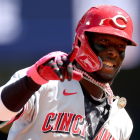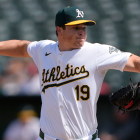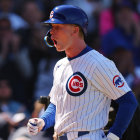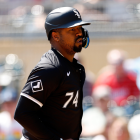It's pretty customary for big-name free agents to take a methodical approach to signing with new teams. The most coveted players have the most crowded and complicated markets, and it takes time to sort out the demand side of things. That's an annual phenomenon that's noteworthy only for the occasional exception.
This time around, though, there's another dynamic working against quick decisions for the likes of Yoenis Cespedes, Kenley Jansen, Edwin Encarnacion and Aroldis Chapman: the expiring collective bargaining agreement (CBA).
The CBA is the negotiated agreement that governs pretty much every aspect of the working relationship between management (the clubs, in this instance) and labor (the players, in this instance). The current CBA is set to expire on Dec. 1. While it appears that no labor stoppage is in the offing and that an agreement will swiftly replace the expiring document, there's some uncertainty looming over the remainder of November. Specifically, two structural components of the CBA have direct bearing on how teams approach the free-agent process, and those components might be very different once the calendar flips to December. To wit ...
The qualifying offer/free-agent compensation system
By way of reminder, if teams tender qualifying offers (one year, $17.2 million for next season) to a pending free agent and the player subsequently declines that offer, then his former team is entitled to a compensatory draft pick once he signs with another club. As for the club that signs him, they must forfeit a high draft pick for the privilege of signing a qualifying-offer free agent. If the signing team picks within the top 10 overall picks, then they forfeit a second-round pick. Otherwise, the signing team forfeits a first-round pick.
It's the second part of the compensation system -- the draft-pick forfeiture -- that's deeply unpopular with the players. The price of that lost pick and the associated bonus pool money gets priced into the offers that the player receives on the open market. In some instances -- Dexter Fowler, Ervin Santana and Nelson Cruz, for instance -- the QO player has sat on the market for an inordinately long time and wound up signing a deal well below market value because of the demand-suppressing loss of a valuable draft pick.
The expectation is that the "penalty" portion of the system is going to go away with the next CBA, while the compensation portion -- i.e., giving the team that lost the QO free agent a compensatory draft pick -- will remain in place in some form. There's no real purpose to dinging the team that signs a free agent other than suppressing wages, and the real surprise is that the players association ever agreed to such a mechanism in the first place.
Anyhow, it follows that almost all of the premium free agents this time around have qualifying offers attached. Players who are traded during the season are ineligible for qualifying offers, which is why Chapman, for instance, has no such market encumbrance attached to him. Most, though, will lose money because of the QO. So if you're a team interested in a QO free agent but don't sense any market urgency, why not wait until Dec. 2 to see whether such a signing will still cost you a 2017 draft pick and a big slice of your 2017 draft budget? Since competing teams are subject to the same calculus, an overall holding pattern is likely.
The 'luxury tax' system
There's another factor to be considered, and it's one that applies even to free agents not subjected to the qualifying offer. MLB operates under what it terms a "competitive balance tax" in the language of the CBA. If a team runs payrolls above a certain threshold for multiple years running, then it gets taxed a certain percentage of that payroll. Under the current CBA -- the one that expires in a couple of weeks -- here are those thresholds ...
The Tax Threshold shall be $178 Million in the 2012 Contract Year, $178 Million in the 2013 Contract Year, $189 Million in the 2014 Contract Year, $189 million in the 2015 Contract Year and $189 Million in the 2016 Contract Year.
You'll note, of course, that no figure is given for the 2017 Contract Year, which is the contract year in question. Presumably, it will go up, but by how much? That threshold is a serious consideration for the handful of teams in danger of activating the competitive balance tax, and not knowing the exact dollar figure means their current offseason budgets entail some guesswork. Teams in danger of getting taxed are also, of course, those that tend to be the most active on the market, so this puts a number of usual free-agent suitors on ice to a certain extent. In related matters, take a look at the players who have already signed -- we're talking about mid-level sorts, at best.
Once these teams know what the compensation system entails and what the luxury tax threshold is, however, the big names may drop in quick succession. As it turns out, baseball's winter meetings -- so often a locus of winter activity -- are scheduled for Dec. 5 through Dec. 8. Tidily enough, the new CBA will almost certainly be in force by then, and as such these market-stifling uncertainties will have gone away.






















